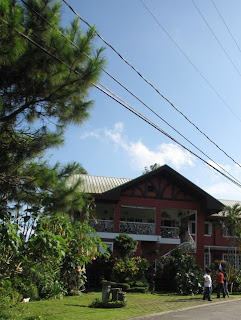

I was about to take a plane out of Kalibo at 2 pm when I got a text message from UP Arch researcher Grace Edralin Servino asking if I could attend the opening of the exhibit with some of our UP classmates. It was a showcase of entries and the winners of the
Ang Pinakamagandang  Bahay sa Balat ng Lupa
Bahay sa Balat ng Lupa contest sponsored by the college and Lafarge cement. I

had the whole hour of the flight to think if I would want to attend but when the plane touched down on the Manila tarmac, I found myself hailing a cab towards the direction of UP. At 5 pm, I was already with Grace and UP teacher Celine Sychangco, viewing and admiring the innovative entries.


Basically the contest was a middle class take on affordable housing in the Philippines. All participants tackled a 200 sq. m. lot and make a very comfortable accommodations for a middle class family with a

750 K construction tag price. In architectural language, the said budget doesn't do much, but

I was surprised on how varied the involved creativity was. But since it is a challenge on Philippine sustainable architecture, a lot of the designs paid homage to the concept of the basic Filipino cube house or

Bahay Kubo. From the words of Arch. Nicolo del Castillo's opening remarks, the Bahay Kubo song put a lot of stress on what was growing around it in the garden. The proposed modern bahay kubo versions played around with integrating

the outside space with the interiors. The traditional Bahay Kubo also made use of indigenous materials available in the immediate environment like bamboo, coconut, nipa, anahao, local woods, etc. These said materials crept its way into the plan and specifications of a good number of entries.

There were modern looks and contemporary updates of the traditional. Some of the houses had direct references to certain native plants. Though I did not have time to scrutinize the entries in detail, I perused though and caught glimpse of bamboo and coconut houses. But what intrigued me the most was the house inspired by one of the rare native flowers of the Philippines, the
 Rafflesia
Rafflesia (the biggest flower in the world).
Rafflesias are parasitic plants and they don't exactly have the most pleasing flower scent, so I doubt that the entry had that in mind for inspiration. But obviously the house tried to mimic the form of the
Rafflesia resorting to curves and rounded surface walls (which I think was at a disadvantage for the budget, as curved walls required a little more attention to detail therefore reflecting a higher labor cost).

The rest of the exhibit pie stuck to rectangular spaces and regular straight walls. Arch Angel Lazaro also entered the design of his unique Bamboo house, which I personally saw constructed in the premises of Carolina Bambo

o Garden in Antipolo. I have a clear picture of his design as I have experienced going into the space and indeed they were both aesthetically pleasing and functionally workable. As for the rest of the concepts they were equally innovative but we still have to see if they were

design and cost feasible, they still have to be constructed to prove their worth. Fortunately for the 2 winning entries in the student and professional categories, they will get to see their designs realized. Only after these are erected and lived in by their prospective occupants would we prove if they really deserve the title of being the most beautiful houses on this face of the earth. Kudos to the sponsors and participants of this unique design contest.
The exhibit
Ang Pinakamagandang Bahay sa Balat ng Lupa would run from October 9 to about the end of the 3rd week of October in the UP Theater Lobby. It is a worth-it thing to see for design students or professionals not only for the bevy of design creativity but also the presentation involved conveying these digital age versions of the traditional Filipino house.
 Apart from the similar ambiance and
Apart from the similar ambiance and  the influx of Igorot riprap makers, a native of the mountain province found its way into the cool air environment of Tagaytay. The Benguet pine or Pinus kesiya, which is native to mainland Asia to the Philippines, adds a refreshing mountain character to the Southern cool haven. Completes Tagaytay as a nearer alternative for the summer capital.
the influx of Igorot riprap makers, a native of the mountain province found its way into the cool air environment of Tagaytay. The Benguet pine or Pinus kesiya, which is native to mainland Asia to the Philippines, adds a refreshing mountain character to the Southern cool haven. Completes Tagaytay as a nearer alternative for the summer capital.

















































